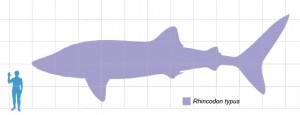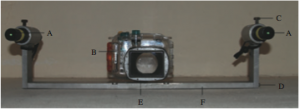This blog has an ironic name. It’s called “The Story of Size: Sizing Ocean Giants” and it’s filled with posts about size and marine organisms. However, have you ever tried to actually size an ocean giant? I have been trying for over a year and it’s hard than you would think.
James H. Brown, a famous ecologist who worked on the body size of mammals, stated that “Body size is easy to measure–all it requires is a ruler (or pari of calipers) to measure linear dimensions or a scale to measure mass.” Brown obviously never tried to measure an ocean giant.
Last year I joined a project to measure the oceans most massive sharks, whale sharks. For unfamiliar readers the whale shark is a gentle giant. Though part of the same family as sharks, it is a filter feeder and a non-aggressive species.

Considering the difference in size, finding an effective way to properly size this ocean giant is difficult.
Although the idea of trying to use a really long tape measure sounds appealing, it would be a challenge to measure a whale shark in motion. Instead we use lasers because… well who doesn’t love lasers?

Researchers suggested using laser photogrammetry, a fancy name for measuring the size of animal from a photo with laser point references. Because of a whale shark’s size, it is difficult to capture its full length in an image. The same researchers suggest that using a premeasured laser rig as a scale (see image below) allows you to compensate for that. Once the image is taken, measurement of certain dimensions can be entered into equations to determine the full length of the whale shark.

Though the numbers are encouraging, when we tried to use laser photogrammetry, we encountered some obstacles. The biggest one is the importance of the actual photo. We found that if the lasers are not perfectly parallel to the whale shark the results can be skewed.
To me, the most difficult part of this method is that it is time consuming. To go through and analyze hundreds of images takes a very long time. Believe me, it is a tall order for a lone undergraduate.

Additionally photo pixilation can affect measurements. During my hours of measuring, we noticed that setting the scale by a difference of one pixel could change the measured length. One of the worst culprits (by no fault of her own) was one of the whale sharks in the Georgia Aquarium named Trixie. When I measured the distance between her fifth gill to start of first dorsal, the same shark ranged in a total length from ~5.3m to ~7.3m (~17.2ft- ~24ft). This is a difference of 2m and nearly 7ft! Not a difference that can be taken lightly, even with a creature this large.
Despite the frustration of perfecting this technique, and the difficulty of sizing ocean giants, it is an important task. Humans are regularly interacting with oceans and we need to know how these interactions are affecting the sea life living there. The reason we started to measure the whale sharks was to see if the whale shark’s interaction with tourists was having a negative effect on the shark population. It has been suggested that sharks shrink if they do not receive proper nutrition. We hypothesized that the increased tourism may negatively affect the food availability for whale sharks. As a result, we want to measure them from year to year to see if there was a significant change. In order to determine the change we needed to find a way to measure the full length of whale sharks. This is the case for whale sharks. Other marine organisms live under the pressures created by humans and though they may not change in the way that sharks do, it is important to have records of size from year to year so that we are aware of any changes. If and when changes are discovered we have to ascertain what was the cause and how to address it. By sizing ocean giants, we can understand more about them and keep them safe.
